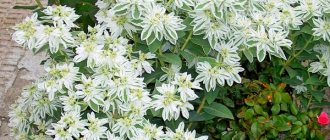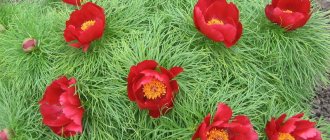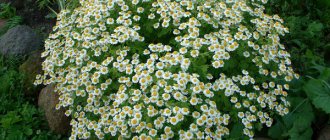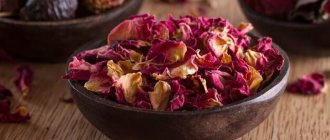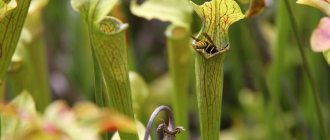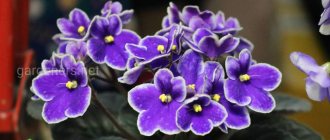The most amazing feature of Mimosa pudica is that it curls its leaves with a light touch. However, the plant is characterized by two types of movements. Like a number of other species of higher plants, mimosa pudica can gradually change leaf orientation over time (nyctinasty), and leaves can close under the influence of external stimuli (seismonasty), such as touch, warming, wind or shaking.
Mimosa pudica. © manuel mv
In 1729, the French astronomer de Meirin reported daily leaf movements in pudica . These movements were repeated with a certain periodicity, even if the plants were placed in the dark, where there were no external stimuli such as light, which made it possible to assume the endogenous origin (geological processes associated with energy arising in the bowels of the Earth) of the biological rhythms to which the movements of the leaves were timed plants. De Meiren suggested that these rhythms may have something in common with the alternation of sleep and wakefulness in humans.
Alphonse Decandolle, a Swiss botanist and biogeographer, determined in 1832 that the period with which mimosa plants make these leaf movements is shorter than the length of the day and is approximately 22-23 hours.
Description and characteristics of mimosa
In the wild, this herbaceous crop grows in the hot tropics of America, Africa and Asia. At home, such a mimosa looks more like a shrub and can even grow up to 1.5 m, although usually lower. The plant has the following characteristics:
- erect stem with small thorns;
- the stem has leaves - 3-5 bipinnate groups that diverge in different directions;
- flowers with a diameter of no more than 2 cm are formed on the tips of the shoots;
- flower shape - round;
- color - pink-lilac shades.
Attention! The leaves of the plant fold at night or even with a light touch. But it is not advisable to play with them - this negatively affects the health of mimosa.
In indoor conditions, mimosa is grown as an annual. Propagation is carried out every year by cuttings or seeds. However, the shoots take root extremely difficult. Mimosa pollen is very small. People with corresponding allergies often react painfully to it.
Mimosa pudica flowers
Application in landscape design
Any floral arrangements in landscape design must correspond to the general idea. In everyday life, mimosa is often confused with certain types of acacias belonging to another genus from the Mimosa subfamily. Mimosa and acacia are surprisingly similar in appearance.
Most often, instead of mimosa, silver acacia or Acacia dealbata is used in decoration. Twigs of this particular flowering plant are traditionally given as gifts on International Women's Day.
Mimosa pudica or touch-me-not can be easily distinguished by touching it with your hand. The response to such a mechanical effect is the folding of all the leaves. The leaves can open only after half an hour or an hour. This protective property is a sure sign of mimosa.
Features of growing indoor mimosa from seeds
To get a full-fledged plant, it doesn’t matter whether you bought the seeds or collected them yourself from a fertilized flower. Pollination of mimosa should be done carefully. There are 2 ways:
- Arm yourself with a brush. Use this tool to transfer dust particles to another flower.
- Rub the mimosa flowers together a little.
Attention!
An external sign of successful fertilization in the photo and in person is the formation of the ovary and thickening of the tip of the stem. After a while, a seed pod is formed. In each of these, 6-10 pieces of mimosa seeds grow. The fruit can be picked when it is completely dry:
- Without opening, wrap the pod in plastic;
- place in the refrigerator at +5 ° C and store in this condition until spring;
- in March, remove and open the fruit. Inside there will be dark pea seeds with a diameter of about 2 mm;
- they need to be sown soon after being removed from the cold;
- Before planting, place the material in warm water for half an hour to further speed up the emergence of seedlings.
Mimosa pudica is sowed in a steamed peat substrate with an admixture of sand or in universal soil from the store. The structure of the soil should be loose and light. You don't need a large container - find narrow bowls with a hole in the bottom. Before filling the container with substrate, lay out an expanded clay layer for drainage.
Attention! Any soil for mimosa must be disinfected. The plant is capricious in this regard.
Step by step sowing goes like this:
- Moisten the soil well. Drain off excess moisture.
- Place the seeds on the surface, followed by a thin layer of the same soil or deepen them 1 cm.
- Cover the crops with film to keep heat and humidity at a constant level.
Temperature and humidity
Due to its light and temperature requirements, this plant is most often grown indoors as a houseplant. An average room temperature of 18 to 23 degrees is ideal for Mimosa pudica as it does not tolerate extreme heat or cold temperatures. It can be grown successfully outdoors in warm climates, although it can spread aggressively and become a weed.
Mimosa pudica has moderate to high humidity. Unless your home is particularly dry, average humidity in the home should be sufficient for Mimosa pudica. Otherwise, install a humidifier nearby or place the pot of Mimosa pudica on a tray of pebbles filled with water.
Caring for mimosa seedlings
The humidity under the mini-greenhouse film should always remain high. The temperature norm is +25…30 °C. Seedlings need to be ventilated once a day. When you remove the protection, water with a sprayer so that the water does not carry the seeds to the surface.
Under good conditions, seedlings can be expected in 2-4 weeks. After this, move the bowls to a sufficiently lit place, without abundant sun. The film can be removed. Humidity must be reduced without going to extremes. But the temperature will be the same as before emergence.
After 3 true leaves appear, the seedlings are ready for picking. For each, prepare a separate small pot. Place a drainage layer at the bottom. Fill the container with a substrate made from a mixture of peat, turf and leaf soil and sand (all in equal parts). Pots should also not be placed in direct sunlight.
Attention! Seedlings should be handled with extreme caution due to their fragile roots.
Mimosa propagation
- Seeds are often used for propagation, but mimosa cuttings can also be rooted. At the beginning of March, the seeds should be scarified, which is carried out according to certain rules, or doused with boiling water.
- Sowing of treated seeds is carried out in a substrate, which consists of two parts peat and part river sand.
- The planting depth of mimosa should not exceed 5 mm. Seeds germinate at a temperature of +25°C.
- Picking is done after two or three true leaves appear.
- The soil needs regular moistening.
Features of growing mimosa pudica
To ensure that the crop grows without problems, during the care process, try to take into account the following features:
- An adult plant loves the sun, so it is better to place it on a southern windowsill. In hot climates, make adjustments towards neighboring cardinal directions. In the shade, the mimosa will stretch out and lose its beauty. But even on the south side, the flower should be shaded from the midday sun.
- From March to October, maintain t +22…+24 °C. The rest of the time - about +17 °C.
- The optimal humidity for mimosa is not lower than 70%. Spraying or placing the pot in a tray with damp material helps maintain it.
- During the active growing season, water once every 2 days. The norm is the moist state of the top layer of soil. In winter, the volume of water should be reduced. Use soft filtered water.
- If, when watering or spraying, drops fall on the leaves, they can burn them.
- Twice a month in warm weather, the flower needs to be fed with mineral fertilizer complexes.
Proper care will give you beautiful mimosa blooms, which last from June for about 4 months. During this period, it is important that the air in the room is clean.
Diseases and pests
- Excess moisture and overwatering cause yellowing of leaves.
- Irregular and insufficient watering can cause leaves to fall off.
- With a lack of light, plant stems tend to stretch and lose strength.
- Low temperatures affect flowering.
- Mimosa is most often affected by aphids and spider mites.
How to care for impatiens at home
Mimosa - what kind of flower is it, what does it look like
Caring for mimosa pudica at home will not require much effort if the requirements for temperature and light conditions are met. In addition, the plant reacts sensitively to watering, spraying and fertilizing with mineral fertilizers.
Indoor Mimosa Pudica reacts painfully to everything
Note! Lack of sufficient experience and skills in growing exotic plants can lead indoor mimosa to loss of decorativeness, disease or complete death. A positive result is possible only if the rules of agricultural technology are observed.
Illumination and temperature conditions
In order for the plant to feel comfortable, bloom long and profusely, it needs good lighting. It is best to place the flowerpot on the windowsills on the south side of the house.
In winter, in the absence of sufficient light, the shy mimosa will require additional lighting. Artificial lighting should provide the plant with at least 10-12 hours of daylight.
Important! Insufficient lighting negatively affects the decorative appearance of the plant: it stretches out or even loses its foliage. Despite the fact that the sissy loves an abundance of sunlight, in the summer heat it should be slightly shaded, otherwise direct sunlight can cause burns. This is especially true for weak plants or young seedlings grown from seeds.
Artificial lighting mimosa
In addition, growing a tropical plant requires strict adherence to temperature conditions. The ideal air temperature for normal seedling growth ranges from 20-24 °C.
In the cold season, when the plant is dormant, the optimal ambient temperature should be between 16-18 °C. Changes or sharp drops in temperature will negatively affect the health of indoor flowers.
Note! Seedlings that require a tropical climate react negatively to heat and dry air. Therefore, it is extremely undesirable to place mimosa in a flower pot near heating radiators or heating devices.
Failure to comply with temperature and light conditions in winter leads to the fact that in the spring the exotic flower will look unattractive. The stems, weakened by lack of light and heat, will become too elongated and their color will become pale green.
Watering rules and humidity
Accustomed to tropical humidity, pink mimosa at home requires abundant watering. This is especially true during the hot season. In the summer heat, when the air temperature exceeds 24-26 °C, it is necessary to periodically spray the seedling. Lack of moisture and low humidity can affect the beauty of the plant: its foliage will turn yellow or begin to fall off rapidly.
For your information! In climatic conditions where day and night air temperatures are not subject to sudden changes, the flower can be placed in the summer on a balcony or in the courtyard of a private house. The main conditions for such a temporary “relocation” are timely watering and periodic spraying.
In winter, the plant does not require frequent watering, as it is at rest. A decrease in air temperature and excess moisture in the soil can cause irreparable harm. The root system will begin to rot, and the seedling will eventually disappear.
Fertilizing and soil quality
In order for the bashful plant to acquire the necessary decorative effect, it requires fertile soil, which can be purchased at a specialized store. It is also possible to prepare the soil yourself. To do this, just mix in equal proportions:
- peat;
- chopped tree bark;
- washed quartz sand;
- perlite
In addition to the fact that the bottom of the flower pot must have a hole, it must be lined with a small layer of charcoal or expanded clay. This will ensure good drainage and protect the root system from excess moisture, which causes rot and fungal diseases.
Important! Garden soil should never be added to the soil mixture. The tropical plant requires loose soil, and soil from the garden plot can compact it.
To maintain the soil in an ideal condition for impatiens, it is necessary to systematically apply organic and mineral fertilizers during the growing season and active growth. The frequency of fertilizing should be at least 2 times a month using the dosage indicated on the drug.
Healthy flowering plant after fertilizing
The optimal period for fertilizing is from early spring to mid-autumn. After the plant has flowered and entered a dormant state, the use of fertilizers should be stopped.
Flower container size
For normal vegetation and crown development, mimosa does not need a large flowerpot. This is due to the fact that the plant does not have a very developed root system. Planting in a larger container is carried out only in the case of planting young seedlings in a permanent place.
Pruning and replanting
Deviations from the rules of agricultural technology and unsatisfactory living conditions can lead to the capricious sissy quickly losing its decorative appearance:
- the foliage will turn pale green;
- the trunk will stretch out greatly;
- leaves turn yellow or fall off;
- the plant will not bloom or stop blooming.
To remedy this situation, flower lovers use intensive pruning or pinching. In this way a beautiful crown is formed.
In exceptional cases, when the plant has overwintered satisfactorily, it can be transplanted into another container. This process is carried out exclusively by transshipment, so as not to damage the roots. To do this, the earthen lump in the flower pot must be slightly dried so that it does not fall apart during the replanting process.
It all depends on the type
For example, Mimosa strigillosa or mimosa powderpuff is a ground cover plant and is actually used as a food source for livestock. This plant is happily eaten by chickens or turkeys, and wild birds, deer, caterpillars and bees feed on it. No part of this mimosa strain has been listed as toxic, so there is no harm to those who eat it.

